Top 5 High-End Storage Arrays 2020
From Dell EMC, Hitachi Vantara, Huawei, IBM and NetApp
This is a Press Release edited by StorageNewsletter.com on August 24, 2020 at 2:22 pm This recent report is authored by Ken Clipperton, lead analyst, storage, DCIG LLC.
This recent report is authored by Ken Clipperton, lead analyst, storage, DCIG LLC.
DCIG Top 5 High-End Storage Arrays
Critical Need for High-end Storage Arrays
Organizations that provide critical infrastructure to the rest of society must provide uninterrupted service availability, even in the event of a disaster.
In hospitals, an interruption in service could mean life or death for a patient. In financial institutions, a brief outage could easily have multi-million dollar ramifications; and an extended outage could have a measurable impact on a nation’s economy as a whole. Organizations in these and other critical industries – such as telecommunications, energy utilities, and transportation – depend on high-end storage arrays to provide uninterrupted access to the world’s most essential data.
Reimagining High-End Storage
If your mental image of a high-end storage array is rack after rack full of blinking lights, you would be right only 30% of the time. Today, nearly half of all high-end storage arrays, including some of the Top 5 products in this report, support configurations that fit into less than 8RU – that is just 14 inches of rack space. Thus, huge floor space requirements no longer define high-end storage.
A high-end storage array must meet a wide array of enterprise requirements. Key attributes include high- performance with high-availability. High-end storage must also integrate into data center management and automation practices, and with critical software applications to secure and protect the data.
Top 5 High-end Storage Arrays in alphabetical order:
- Dell EMC PowerMAX Series (8000)
- Hitachi Vantara VSP 5000 Series (5500/5500H)
- Huawei OceanStor Dorado V6 Series (18000 V6)
- IBM FlashSystem 9000 Series (9200)
- NetApp AFF and FAS Series (AFF400/FAS8700)
Similarities among the Top 5 High-end Storage Arrays
Beyond meeting the criteria for inclusion, they share the following characteristics:
• Scale-out to at least 8 controllers for high availability and scalability
• QoS options that facilitate confident consolidation of many workloads
• Support NVMe media to enable consistent low-latency
• Data efficiency features including compression and inline deduplication
• Robust virtualization integrations
• Predictive analytics, including capacity planning,
and proactive support to maximize uptime
• Available on-premises as-a-service
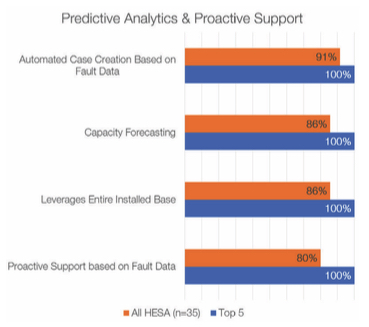
What Differentiates Top 5
High-end Storage Arrays Performance resources. The Top 5 generally provide more performance resources than other arrays, from CPU cores to DRAM caches and storage network connectivity. All these arrays support NVMe back-end connections to storage media. All but one extend NVMe to application hosts across the FC fabric via NVMe/FC. The reduced protocol overhead of NVMe frees up CPU cycles on the host while also reducing storage latency.
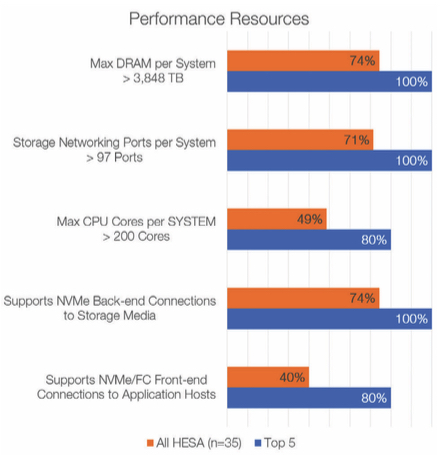
Capacity and density. The Top 5 also distinguish themselves from other arrays – and among themselves – by the scalable capacity and storage density they deliver. These features complement the performance resources of the array, providing dramatically more performance per floor tile and increasing the amount of work any data center can provide.
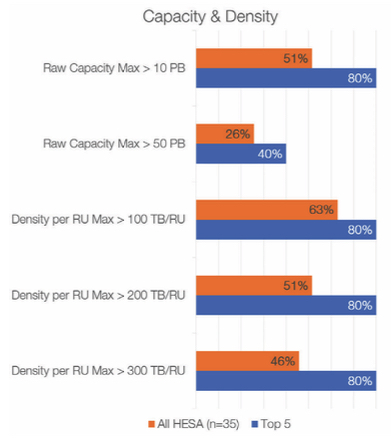
Similarly, acquisition and deployment options distinguish the Top 5. While all offer on-premises storage-as-a-service options, only 2 of 5 provide similar capabilities in the public cloud.
Storage virtualization. Four of them can integrate and manage the storage capacity of other vendor’s arrays. This extends new capabilities to old storage and reduces storage management overhead. The extent of this capability varies significantly, even among the Top 5, but generally includes tiering, compression, and deduplication.
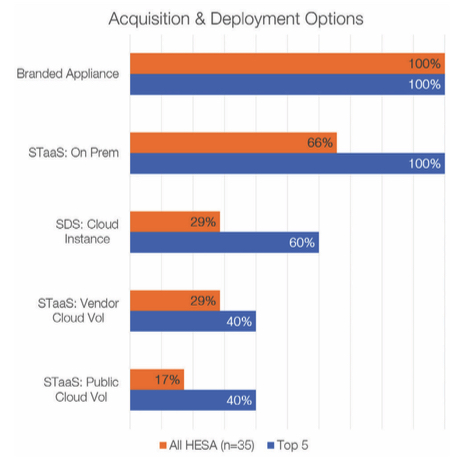
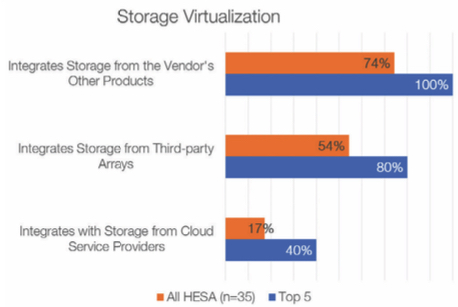
Other Differentiators Between Top 5 High-End Storage Arrays
• Performance claims around latency and throughput
• NVMe/FC support
• Hybrid cloud capabilities
• QoS options
• Support for both block and file (SAN and NAS) protocols
• Public cloud integrations
Top 5 High-End Storage Array Solution Profiles
Dell EMC PowerMAX Series (8000)
PowerMAX is the current name for what was once called Symmetrix, arguably the most successful enterprise storage system in history. Dell announced the PowerMAX brand when it released the product as an all-NVMe array.
The product provides end-to-end NVMe/FC connectivity and supports only NVMe-attached storage, including standard SSDs plus storage class memory (SCM) drives of 750GB or 1.5TB. It uses SCM as a storage tier and can be configured entirely with SCM. It is the only Top 5 array that does not support SAS-attached media. The company rewrote the HYPERMAX OS to optimize it for NVMe, rebranding it as PowerMaxOS.
The PowerMAX 8000 scales to 4.4PB of NVMe storage capacity. The system scales out to a maximum of 16 controllers which are sold as dual-controller ‘bricks.’ A fully scaled-out 8-brick system supports up to 256 storage networking ports and 16TB of DRAM. Like prior generations of the product, it uses DRAM as a write cache that it de-stages to NVMe flash as needed.
PowerMAX is available in 2 models, the 2000 and 8000. The 2000 scales to a total of 4 controllers in 2 bricks.
The company has simplified software licensing for its PowerMAX arrays. Although retaining some a-la-carte elements, it has moved toward all-inclusive licensing by offering 2 software bundles for open systems and 2 bundles for mainframe environments. DCIG evaluated the products based on the extended ‘Pro’ bundle.
Hitachi Vantara VSP 5000 Series (5500/5500H)
The series is the new high-end of the Hitachi VSP product line. Hitachi Vantara supports up to 12 controllers in a scale-out cluster; and claims up to 21 million IO/s, 149 GB/s of throughput and latency of 70MU????s for the product. The VSP 5500 scales to 69PB of raw ash capacity at up to 319TB per rack unit.
All VSP arrays run the Hitachi Storage Virtualization Operating System (SVOS RF), which has now been optimized for the parallelism of NVMe. As this name implies, the VSP can integrate storage from nearly any third-party array, incorporating those arrays into its sophisticated management and data services environment. Licensing is based on bundles plus a la carte features.
The Hitachi Ops Center goes beyond traditional storage management functions to include the Ops Center Analyzer, Automator, and Protector. Ops Center Analyzer provides AI and ML assisted cross-stack root cause analysis and recommended remediations, plus ‘What if’ forecasting capabilities. Analyzer runs on-premises as a VM or on a dedicated host. The Ops Center Automator software supports automated workflows, including provisioning and online data migrations. It offers an open API to integrated with existing data center automation tools.
Automation is a journey that many businesses want to pursue; yet they lack the experience, skills and resources to get started. To overcome these barriers to innovation, the company is now offering a low cost ‘Automator Starter Pack’. This service helps businesses implement the Automator software and automate two workflows. As part of the engagement, which typically occurs across a 90-day window, IT staff learns how to apply Automator to their workflows. The benefits of automating the work ows are quantified for the customer.
Firm’s cloud-like pay-per-use offering if called EverFlex Consumption. It ranges from basic utility pricing to full storage-as-a-service on-premises or in a Hitachi-managed data center.
Huawei OceanStor Dorado V6 Series (18000 V6)
The series is end-to-end NVMe based. Up to 8 4RU quad-controller enclosures can be interconnected to form a 32-node SmartMatrix full-mesh cluster supporting 100GE NVMe over RoCE interconnection. This resilient architecture permits an 8-controller cluster to lose 7 controllers and still serve data.
The OceanStor Dorado V6 series features company’s own Kunpeng 920 ARM-based 48-core 2.6GHz processors. Each quad-CPU controller adds 192 cores and up to 1,024GB of DRAM to the cluster. The OceanStor Dorado 8000 V6 and 18000 V6 support the firm’s developed smart disk enclosure and developed SSDs. The smart disk enclosure has its own CPU and memory that are used to of offoad tasks from the main CPUs, such as data reconstruction upon a disk failure. FlashLink associates controller CPUs with SSD CPUs to coordinate flash media optimizations and SSD algorithms between these CPUs.
The OceanStor Dorado V6 offers the highest raw storage density among the Top 5 at up to 553TB per rack unit to a total of 32.8PB. This unified storage capacity is accessed via up to 768 ports of host connectivity, including 8/16/32 Gbit/s FC/FC-NVMe, 10/25/40/100GbE, and 25/40/100 NVMe over RoCE.
Huawei’s SmartQoS provides comprehensive quality of service capabilities. It ensures that the required IO/s, bandwidth or latency requirements are met. Firm’s SmartVirtualization integrates the storage from heterogeneous storage systems. It eliminates data silos, simplifying storage management, data migrations, and disaster recovery procedures. In addition, OceanStor Dorado 8000 V6 and 18000 V6 storage systems incorporate dedicated Ascend AI chips that dynamically optimize the performance of many applications.
The company offers proactive support and predictive analytics via its eService Intelligent Cloud Management System, which relies on periodic collection and uploads of operations data including alarms, configuration data, performance data, system logs, and disk information.
It offers the OceanStor Dorado V6 Series arrays as branded on-premises arrays. Licensing can be all-inclusive or based on feature bundles plus a-la-carte licenses for premium features. it also offers flexible capacity through an on-premises storage-as-a-service option.
IBM FlashSystem Series (9200)
The series provides end-to-end NVMe data transfers through support for both NVMe SSDs and NVMe/FC. The company claims it can deliver more IO/s (2.2 million) and bandwidth (22.5GB/s) through each of its FlashSystem 9200 controllers than any other product in this report.
The FlashSytem 9200 is based on a 2RU, dual-controller enclosure that supports up to 24 industry-standard NVMe drives or IBM FlashCore Modules (FCM). It also supports up to 4 NVMe SCM drives per enclosure. These SCM drives are based on Intel Optane or Samsung zSSD in capacities ranging from 375GB to 1.6TB each.
FlashCore Modules provide inline hardware compression, data protection, and specialized flash management features. 38.4TB FCM is the largest SSD supported by any array in this report; which helps explain the high storage densities (461TB/RU) the array can provide.
The firm recently simplified is storage line, eliminating the Storwize brand. The FlashSystem product line all run the Spectrum Virtualize storage OS. Some features are only available on the more powerful models, including support for NVMe drives, SCM, and external storage virtualization.
FlashSystem can virtualize more than 500 third-party storage systems. This brings legacy storage into the FlashSystem management domain and extends its comprehensive enterprise class data services to those arrays. This capability facilitates data migration to the FlashSystem. Longer term, firm’s integrated Easy Tier AI-driven automated tiering can use legacy third-party systems as a tier of storage.
IBM’s combination of hybrid cloud capabilities and external storage virtualization of 500+ arrays is unique among products in this report. This enables the FlashSystem to bring hybrid cloud capabilities to nearly any existing storage array.
The company offers much flexibility in acquisition and deployment of these systems, including storage-as-a-service on-premises, in IBM’s cloud, and in the public cloud.
It offers all-inclusive and ‘bundles plus a la carte’ licensing options on the FlashSystem 9000 Series.
NetApp AFF & FAS Series (AFF400/FAS8700)
These arrays provide highly scalable storage. The company offers the highest raw capacity of any system in this report at 140PB when fully scaled out in a 24-node federated cluster. The A400 can provide up to 360TB/RU of dense all-flash storage. The AFF series utilizes an NVDIMM write cache to accelerate performance. The firm claims latencies of under 100MU????s, 300 GB/s of throughput and 11.4 million IO/s rom a fully scaled-out cluster.
The company was the first mainstream enterprise storage vendor to release end-to-end NVMe support via NVMe/FC. It supports the full range of connectivity options including 16/32Gb FC and 10/25/40/100GbE for connection to application hosts.
It offers the most extensive set of acquisition and deployment options of any product in this report. It runs on the ONTAP storage operating system, which can also be deployed as software-defined- storage on-premises or in the cloud, with some limitations in capacity and features compared to the AFF A400 appliance.
ONTAP can virtualize some third-party storage arrays, including arrays from Dell EMC, Hitachi Vantara, HPE and IBM. This allows capacity from the legacy storage system to be incorporated into the ONTAP storage environment.
NetApp provides pre-built integrations into all the automation frameworks that DCIG included in its research. This facilitates rapid integration into the operations of the data center. ONTAP provides a wide range of quality of service features that facilitate workload consolidation.
DCIG identified 35 different solutions that met its inclusion criteria.
The products come from 9 different vendors: Dell EMC, Fujitsu, Hitachi Vantara, HPE, Huawei, IBM, Infinidat, NEC and NetApp.













 Subscribe to our free daily newsletter
Subscribe to our free daily newsletter


